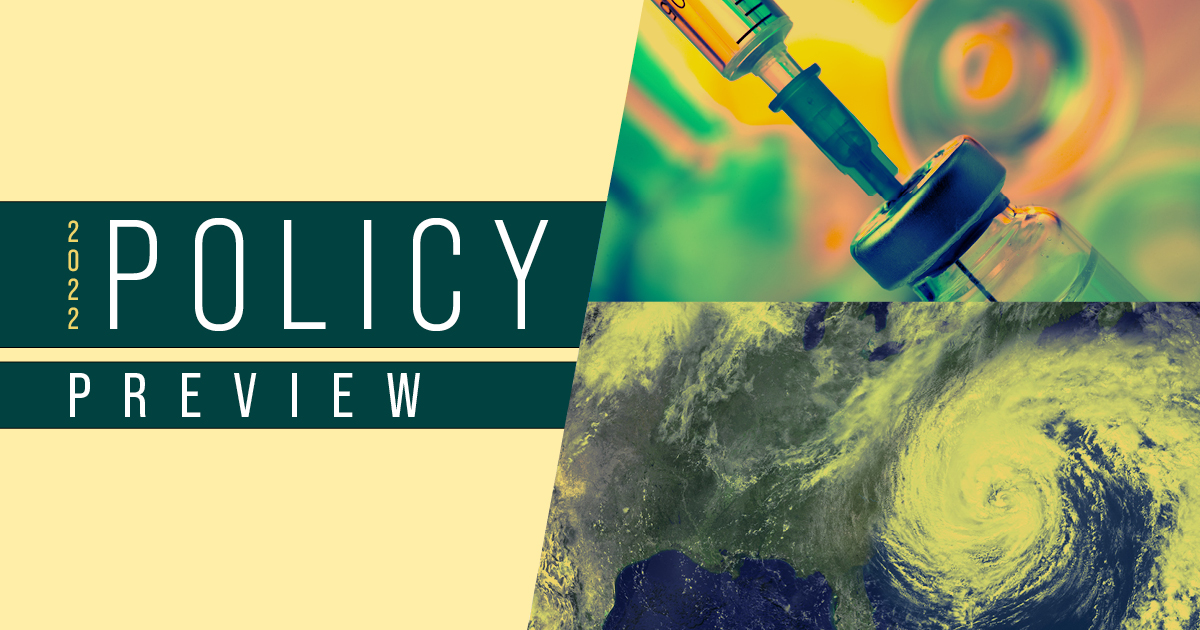
Entering the third year of the COVID-19 pandemic, states, localities and regions will continue to face new and ongoing challenges that impact the stability of state economies, viability of communities and well-being of residents.
As policymakers look ahead to mitigate issues and capitalize on opportunities, CSG is providing evidence-based, nonpartisan resources across fiscal, civic, workforce and health policy areas.
These are the top issues we expect to be prominent in state leaders’ decision-making in 2022, along with insights from the CSG public policy research team.
The CSG policy research team is available to partner with policymakers on research projects related to these and other issues facing the states. If you have a research request or would like more information, please contact Sarah Needler, director of research, at [email protected].
Pandemic
During the early days of the COVID-19 pandemic, state budgets experienced substantial shock caused by dramatically reduced revenues and increased costs, particularly in health and social services. This escalated to caring for those who test positive and those whose livelihoods were devastated. Recovering economies and a significant influx of federal dollars have returned most states to a stable position.
In response to the health crisis, governors and state legislatures have been defining their respective spheres of authority and the relationships between the branches, aided by rulings from federal and state courts. Flashpoints are occurring with greater regularity as legislatures are in session and questioning the authority of governors to impose mask mandates and lockdowns. With the pandemic seeming to be a condition of existence, the branches of state government will continue to negotiate the changes in state action, mindful that responses to current conditions set precedents for future exercises of authority.
CSG researchers have written several policy briefs related to the impact of the pandemic and efforts toward increased resilience in state government programs and policy. Learn more at web.csg.org/recovery.
Redistricting
The U.S. Supreme Court has granted considerable deference to the states in determining the shape of legislative districts, with the primary proviso that they must be approximately equal in terms of the number of people within them. This is true at the state (Reynolds v. Sims, 1964) and federal (Wesberry v. Sanders, 1964) levels. Despite numerous appeals over the years for the Court to prohibit the political drawing of legislative maps, the Court had long been reluctant. Much of the challenge has been an inability to craft a legal test for “overly political” that lower courts could utilize effectively in reviewing maps. The final word came in 2019, when the Court ruled that how districts are drawn is a “political question” that courts are ill-equipped to consider (Rucho v. Common Cause). Chief Justice John Roberts wrote: “Partisan gerrymandering is nothing new. Nor is frustration with it. The practice was known in the Colonies prior to Independence, and the Framers were familiar with it at the time of the drafting and ratification of the Constitution.”
Federal courts still insert themselves into legal disputes as to whether districts are drawn to disadvantage individuals on the basis of race in violation of the Voting Rights Act. For example, on Jan, 24 a federal court ordered Alabama policymakers to redraw the recently approved congressional map (Milligan v. Merrill). The Supreme Court reversed the decision Feb. 7.
Thirteen states gained or lost seats in the U.S. House of Representatives due to population shifts reflected in the 2020 Census. Seven states (California, Illinois, Michigan, New York, Ohio, Pennsylvania and West Virginia) lost one seat, five states (Colorado, Florida, Montana, North Carolina and Oregon) gained one seat and Texas gained two seats.
Though state legislatures are generally positioned by statute to do the work of drawing boundaries, 14 states have formed commissions (four of which have their decisions reviewed by the legislature, governor or both).
States should complete their work in time for changes to be effective for the 2022 election cycle. Therefore, candidate filing deadlines generally dictate when redistricting processes must be completed (though some states impose statutory deadlines).
By Feb. 17, 41 states had completed work on their congressional maps. Six states (Alaska, Delaware, Montana, North Dakota, South Dakota, Vermont and Wyoming) only have one House member.
While the U.S. Supreme Court has taken the federal courts out of the debate, state courts have been active participants in reviewing the work of legislatures and commissions under state law. For example, on Jan. 14, 2022 the Ohio State Supreme Court struck down the state’s new map as overly political, in violation of the state constitution (Adams v. DeWine). There are and will likely be more legal challenges in state court that will sustain uncertainty for much of the year.
K-12 Education
The COVID-19 pandemic has significantly disrupted learning for K-12 students. For example, two organizations that assess student achievement — NWEA (MAP) and Curriculum Associates (iReady) — found lower-than-average performance since the spring of 2020. An NWEA brief from December 2021 highlights that learning gaps grew for underserved populations. Black, Hispanic, American Indian and Alaska Native students, as well as students in high poverty schools, faced disproportionate declines.
A December 2021 Curriculum Associates report compared iReady data from before and during the pandemic and determined that students who already were one grade level behind faced the most severe decline in learning. The report also signals substantial erosion among underserved and at-risk populations.
As 2022 legislative sessions continue and policymakers consider remedies, many schools already are using intervention/remediation programs in the return to traditional schooling. States have filed, and some have passed, legislation that appropriates funds for programs to target academic shortcomings. Further evaluation of these policies and outcomes could help states target academic achievement lost due to the COVID-19 pandemic, particularly among vulnerable populations.
Workforce Development
Trending policy issues within workforce development include COVID-19 response and recovery, skills training and diversity and inclusion in labor and employment. Under the umbrella of COVID-19 recovery, states as regulators of the workplace and as employers are grappling with the need to upskill workers, increase wages and refine paid leave requirements, mask and vaccine mandates and telework policies. Further, 42 states currently have more jobs than people to fill them.
States have employed several solutions, including increased investments in worker training, modified licensure requirements, changes to minimum wage, increased employer incentives and investment in local businesses. States have turned to policies focused on addressing the digital divide, reskilling and upskilling programs and mechanisms for addressing mental health consequences of the pandemic.
Skills training has been a national priority for the past year, with a specific emphasis on apprenticeships. States are focused on developing programs that are inclusive, tailored to new industries such as technology and green energy and that can rebuild local economies. For example, given the disproportionate impact of COVID-19 on minority populations, states have begun to address the unique needs of these workers to ensure they have equal access to vaccinations, accommodations and safety-conscious work opportunities. Some states have opted to create cabinet-level positions or offices focused on diversity, equity and inclusion, require diversity statements for state offices and focus on the intersectional needs of diverse populations in community services.
Housing and Food Insecurity
Housing insecurity is defined as the lack of security caused by high housing costs relative to income, poor housing quality, unstable neighborhoods or overcrowding, and it impacts millions of people in the U.S. Causes and solutions are often discussed in two categories.
One approach advocates loosening zoning regulations to allow for faster housing development. With rising demand for housing, strict zoning laws — like mandated minimum lot sizes and restricted multi-family development — hinder the supply of housing and increase its price.
Another camp views the lack of stable, affordable housing as the bigger issue, with faster housing development and reformed zoning laws playing only a secondary role. For example, the Urban Institute finds that for every 100 low-income households in need of affordable housing, only 29 units are available.
The U.S. Department of Housing and Urban Development reported that more than 7 million households with very low incomes pay more than 50% of their household income toward housing costs, with little left over for other necessities such as food. Housing and food insecurity, or “the inability to provide all household members at all times with enough food for active, healthy lives,” according to the U.S. Department of Agriculture, historically have coincided. Research has shown that families in subsidized housing had a lowered risk of food insecurity.
Mental Wellness

Nearly half of people in the U.S. (46%) will meet the criteria for a diagnosable mental health condition sometime during their lives. Even greater mental health stressors are occurring during the COVID-19 pandemic. Isolation, economic strain and uncertainty about the future can lead to psychological distress. Compounding this are mental health disparities in health care quality among people of different races, ethnicities and identities, as well as differing socioeconomic status, geographic location and education.
The global pandemic has placed a spotlight on long-standing challenges in providing mental health services, such as provider shortages, limited access to care and lack of insurance coverage. State policymakers recognize that the mental health of their constituents needs more attention, and they are already are implementing measures to ensure mental health needs are being met.
For example, the CSG Mental Health Resource Guide for State Policymakers highlights challenges and solutions across four areas in mental health policy: social isolation and loneliness, maternal mental health, social determinants of health and mental health insurance parity. To read the guide, visit csg.org/mental-health.
Cybersecurity and Broader Technology Issues
The public continues to express concern about various issues related to the advance of technology. But while there has been some bipartisan consensus on the need to do something, Congress has yet to pass legislation. States are increasingly assessing policy areas, including data privacy and protection, cybersecurity, content moderation, net neutrality and antitrust.
Technology companies regularly collect millions of points of data on individuals. From online searches to social media posts, activity is tracked and catalogued to create a profile of an individual, allowing for tailored ads and sponsored content.
It is likely other states will mirror the California Consumer Privacy Act, which allows consumers to retain and delete their data, as well as opt out of data collection. State policymakers can explore codifying more aggressive policies to protect information and infrastructure.
Additionally, states can require information brokers to collect data responsibly by having stricter security protocols and procedures. California requires businesses to disclose where exactly the consumer’s information is going, upon request.
In 2019, a study by the Pew Research Center found 81%of people believe they are unable to control the data collected by companies. Vulnerabilities in cybersecurity surrounding public and private sector data holdings have been exposed in recent years, in a series of cyberattacks against businesses and individuals. Chinese and Russian infiltration shows U.S. policies are often ineffective. There are several reasons for the porous firewalls, including an insufficient workforce of cybersecurity professionals and the lack of an overarching strategy to protect vulnerable data.
State legislatures can create digital rights for residents, which include requiring companies that profit from disclosure of individual information to third parties, to gain consent from and provide compensation to individuals.
In addition, there has been frequent discussion about the duty of social media companies to monitor and moderate the content on their platforms. From misinformation and hate speech to protecting young people from content that promotes unhealthy behaviors, states may feel a duty to actively moderate content.
Net neutrality is the principle that internet service providers must treat all internet communications equally, without discrimination or different charges based on user, content, website, platform, etc. Following the 2017 repeal of federal net neutrality requirements, several states have already adopted net neutrality laws. More legislation will be considered this year.
Cryptocurrency

The complexity and rapid growth of cryptocurrency requires policymakers to gain a better understanding of its essentials in order to best regulate its exchange, protect participants and prevent illegal activity.
Cryptocurrency is any decentralized currency that exists solely in electronic form and is stored via what is known as a blockchain. Many (but not all) cryptocurrencies are mined, or virtually printed in a decentralized fashion as well. In theory, cryptocurrencies can be used to buy and sell goods and services. In practice, however, cryptocurrencies are used more as a speculative vehicle (an investment) rather than as an actual means of exchange.
A blockchain is a decentralized ledger that tracks the ownership of all tokens (“coins”) for a specific cryptocurrency. This database is shared peer-to-peer, meaning everyone who has coins also has a database of all coins. Cryptocurrencies are theoretically impossible to counterfeit, as coins and transactions are accounted for among all users and any attempt to modify the ledger will be detected. This creates trust among individuals without the need for a third party (i.e. a bank, central bank, and/or government) to verify transactions.
Cryptocurrencies are largely mined into existence by a decentralized network of computers. These computers essentially are rewarded with coins for solving increasingly complex math problems.
Bitcoin is a specific cryptocurrency (the first one created), though there are many cryptocurrencies in existence (e.g. Ethereum, Dogecoin, Litecoin). Bitcoin is also sometimes used as the generic term for all cryptocurrencies.
Cryptocurrencies exist outside the control of governments and banks. This may reduce their susceptibility to inflation, for example, because there is no ability to print more. But this makes them attractive for criminal activity. Mining Bitcoin uses 91 terawatts of electricity per year (the same amount of energy used in Finland, population 5.5 million people). Bitcoin mining also contributes to the current computer chip shortage, as computer components are seeing increased demand for use in mining.
Extreme Weather
According to the National Oceanic and Atmospheric Administration, in 2021 the U.S. suffered 20 extreme weather events that each inflicted over $1 billion in damage and resulted in a total of 688 fatalities. The cycle is familiar. An event causes extensive damage and states and localities request recovery assistance from the federal government to combine with state and local pools of funds and private insurance for business and homeowners.
The Infrastructure Investment and Jobs Act passed in November 2021 includes $50 billion for climate-related initiatives designed to protect against such events. Broader conversations at the federal level about climate change and responses to it have stalled, largely in the context of negotiations over the Biden Administration’s “Build Back Better” package.
As stewards of expansive infrastructures, states can affect energy consumption and, therefore, climate change. For example, state governments traditionally maintain large fleets of official vehicles. Transitioning those to more energy-efficient models saves money and reduces emissions. As builders and maintainers of thousands of office buildings, states can engineer and refurbish facilities with energy-conscious lights, water systems and heating and cooling machinery.
States also can continue to incentivize individuals and businesses to reduce emissions harmful to the climate. Easement incentives for landowners, recruiting businesses in the alternative energy sector, subsidies for the development of bicycle, scooter and pedestrian paths and other efforts can substantially reduce a state’s carbon footprint.


